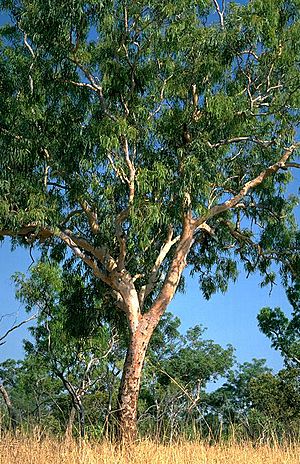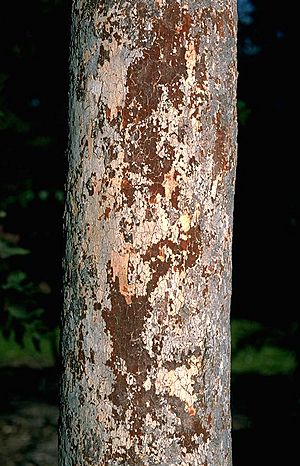Glossy-leaved bloodwood
Quick facts for kids Glossy-leaved bloodwood |
|
|---|---|
 |
|
| Eucalyptus bleeseri near Katherine | |
| Scientific classification | |
| Genus: |
Corymbia
|
| Species: |
bleeseri
|
| Synonyms | |
|
|
The Corymbia bleeseri, often called the glossy-leaved bloodwood or the smooth-stemmed bloodwood, is a special tree. It is found only in northern Australia. This tree has rough bark on its lower trunk. Higher up, its bark is smooth. It also has shiny, long leaves, creamy white flowers, and fruit shaped like a barrel.
What Does the Glossy-leaved Bloodwood Look Like?
The Glossy-leaved Bloodwood is a tree that usually grows between 8 to 15 metres (26 to 49 ft) tall. It has a special woody swelling at its base called a lignotuber. This helps the tree regrow if there's a fire.
Its bark is thin and rough, with a scaly, puzzle-like pattern. It can be greyish and red on part or all of the trunk. Above this, the bark is smooth and can be white, cream, or pale grey.
Young plants and new shoots have dull grey-green leaves. These leaves are heart-shaped, egg-shaped, or lance-shaped. They measure 40–140 mm (1.6–5.5 in) long and 25–65 mm (0.98–2.56 in) wide. They grow in pairs opposite each other.
Adult leaves are shiny green and shaped like a lance or slightly curved. They are 75–150 mm (3.0–5.9 in) long and 9–27 mm (0.35–1.06 in) wide. They narrow down to a leaf stalk, called a petiole, which is 10–28 mm (0.39–1.10 in) long.
The tree's flower buds grow at the ends of its small branches. They are on a thin, branched stalk called a peduncle, which is 5–30 mm (0.20–1.18 in) long. Each part of the peduncle has seven buds. These buds sit on smaller stalks called pedicels, 6–30 mm (0.24–1.18 in) long.
When the buds are ready, they are oval to cylinder-shaped. They measure 8–15 mm (0.31–0.59 in) long and 5–8 mm (0.20–0.31 in) wide. Each bud has a rounded cap on top, called an operculum.
The Glossy-leaved Bloodwood flowers between March and July. Its flowers are a creamy white color. After flowering, the tree produces a woody fruit. This fruit is shaped like a barrel and is 15–25 mm (0.59–0.98 in) long and 10–15 mm (0.39–0.59 in) wide. The parts that release the seeds are hidden inside the fruit.
How Did This Tree Get Its Name?
The Glossy-leaved Bloodwood was first officially described in 1927. A scientist named Blakely gave it the name Eucalyptus bleeseri. This happened in a science journal called the Journal and Proceedings of the Royal Society of New South Wales.
Later, in 1995, two other scientists, Ken Hill and Lawrie Johnson, changed its name to Corymbia bleeseri.
The second part of its scientific name, bleeseri, honors a man named F. A. K. Bleeser. He was an Assistant Postmaster in Port Darwin. He was very interested in the plants and animals of the Northern Territory for over 38 years.
Where Does the Glossy-leaved Bloodwood Grow?
The Corymbia bleeseri tree grows in open forests and woodlands. It prefers soils that are well-drained, like lateritic or sandstone soils. Lateritic soils are rich in iron and aluminum, often reddish. Sandstone soils come from broken-down sandstone rock.
You can find this tree on flat areas and plateaus. Its range stretches from near Derby to Cambridge Gulf in Western Australia. It also grows in the Top End of the Northern Territory and on nearby islands.


